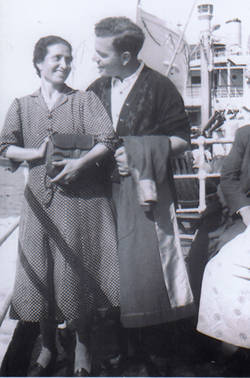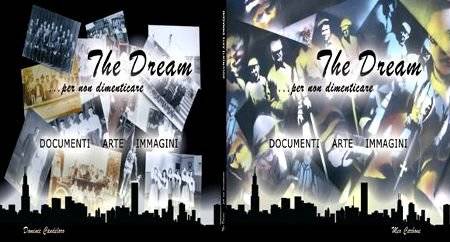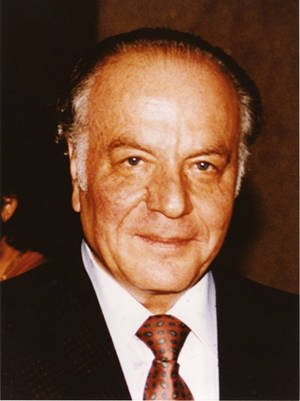Reflections on "A Dream... per non dimenticare"
Now, only now for every suffered wrong
do I discover who I am at last
the multitudinous Italian throng.
I am the present for I am the past
of those who for their future came to stay,
humble and innocent and yet outcast.
I am the dream of their eternal day
the dream they dreamed in mines bereft of light —
I am their darkness and their only ray,
their silence and their voice: I speak and write
because they dreamed that I would write and speak
about their unrecorded death and night.
0 glory! I'm the bread they came to seek,
the vine they planted to outvanquish doom,
their most majestic and enduring peak.
For this my life their death made ample room.
From Joseph Tusiani"s "Song of the Bicentennial"
Italian AMERICAN history and culture is at risk of being lost. Direct memory of the grand saga of Italian migration to the United States, the Little Italies that they built, the family-based culture that they kept, their broken English, their political radicalism, their brand of religion, and their dreams are almost forgotten on both sides of the Atlantic.
Emigration/Immigration have been basic themes in recent Italian history and in American history. Indeed, the movement of peoples is an important factor in all history. “The Dream... per non dimenticare” is an eclectic collection of photographic material from 20 important collections of Italian Americana in the USA and Italy. We accept the poet’s mission to speak and write about the humble immigrants and their dreams.
From this exhibit we get glimpses and echoes of the Italian American past. The material is rich, but it is not complete, indicating both how far we have come in reconstructing Italian American history and how much further we need to go to complete the story. The American Italian Historical Association and its members along with the Fondazione Agnelli and various study centers in Italy have made heroic efforts and produced many books and articles. Professor Frank Cavaioli has contributed images of, Giovanni Schiavo and Leonard Covello, the pioneering scholars of Italian American. There remains much work to be done in collecting additional historical materials, especially from the post World War II migration. Advanced technology will allow additional tools for collection and interpretation of data.
This exhibit also begs the question: Is this slice of history worth saving? In this third millennium, with all of our preoccupation with problems like terrorism, global warming, the explosion of information on the Internet and our fascination with sports and dozens of other interests that compete for our attention, do we have the energy and will to preserve and disseminate small page in world history? Are we (Italians, Americans, and Italo Americans) sufficiently interested in this material because of what it tells us about ourselves and our respective countries? Or, as we move toward a global culture, will we satisfy ourselves with the superficial stereotype of the poor hardworking immigrants whose Italian American children and American grandchildren moved up in the world and whose Italian names and memories dissolved into the American “Melting Pot”? Italian American organizations that protest against mafia stereotyping, promote religious festivals, and celebrate Columbus Day will always be there. Italian business, cultural, and governmental entities which can benefit from an Italian American identity, no matter how superficial, will also be present. The question is whether future generations on both sides of the Atlantic will have access to the rich authentic details of Italian American political, cultural, and social life? “The Dream... per non dimenticare” is our modest effort to preserve the vestiges of a culture to which we owe so much.
Since the initiative for this exhibit began with the traveling version of the “Italians in Chicago” exhibit, images from that city are most numerous in “The Dream..per non dimenticare.” In these photos, collected from individuals and families over a two year period, we see the proud workers, even at humble jobs, small businessmen posing proudly in front of their stores, families and societies enjoying picnics and weddings, and mutual benefit societies celebrating religious festivals. A dozen Italian Catholic churches and church schools under the tutelage of the Scalabrini Fathers tended to the religious and social needs of the various “Little Italies” of Chicago. Despite all the challenges of emigration, Italians showed a remarkable capacity for hard work and self sufficiency.
The “Con Le Nostri Mani” segment of the exhibit comes to us from Laura Ruberto and her colleagues in the San Francisco Bay Area. The images remind us that the immigrants brought with them the resourcefulness and practical skills especially of Italian women. The immigrants tended gardens, canned tomatoes and other vegetables, and made their own wine and sausage. The barbers, tailors, bakers, and even some doctors and lawyers helped to make institutionally complete Italian neighborhoods in the 1920s and 1930s.
Perhaps the most exciting single day in the history of Italians in Chicago was July 15, 1933 when Italo Balbo arrived with his squadron of seaplanes at the Century of Progress World’s Fair. Thousands of Italians flocked to see Balbo and thousands more read the newspaper notices. After suffering from the negative images of being poor, illiterate immigrants as well as the Capone-gangster stereotype, with Balbo, Chicago Italians at last had something wonderful of which to be proud. The material on display from both sides of the Atlantic, well-illustrates the joy and pride that Italo Balbo ‘s flight engendered in the Italian American people. These happy feelings and the pride that Italians took in the progress of the Fascist Regime turned to ashes in 1941 when Italy became an enemy in World War II.
Nicholas Ciotola, Curator of the Italian American Collection of the Western Pennsylvania Historical Association, has provided images depicting the Italian community in Pittsburgh at work, at play, and making wine. These photos trigger a nostalgia for a time past when a sense of community was strong, even if the members of the community were not well off.
The most colorful element of the exhibition is contributed by Paul Porcelli of Newark, New Jersey. A scholar fascinated with Italian American religious street festivals, Porcelli is working on a book, “When the Saints come Marching Out.” He has per sonally attended and photographed over 240 of the 300 Italian saint processions in the US. While the number of festivals has declined from 3000 in the 1920s, the strong survival of 300 into the Twenty First Century is still clear testament to the strength of Italian religiosity and ethnicity. These festivals also remind us that the lives of immigrants and their descendants consisted of much more than the deprivation and alienation that are the hallmark of the migration process.
Bobby Tanzilo, a member of the Monferrini Society, has provided images typical of the photos of the period: Stiff, format portraits that suggest the stubborn determination of the immigrants to succeed.
Professor Salvatore LaGumina shares with us his images of Italians on Long Island, New York. Here in “Marconiville” (Copiague) or Deer Park immigrants could retreat from city life where they could own a home, a plot of land for a garden, and abundant fishing. Professor Jerome Krase of Brooklyn College has contributed a photo essay on Italian American use of urban spaces. His focus is on the continuity and change in the oldest and newest Italian enclaves in New York City. His “New York City’s Little Italies: Yesterday, Today-and Tomorrow?” was featured in a recent exhibit curated by the late Professor Philip Cannistraro. The article can be found in the “The Italians of New York” catalogue which is available for those who want to know more about New York Italians.
New Orleans Italians are descended from a large Sicilian migration from such towns as Cefalù, Contessa Entellina, Sambuca, and Quisquina in the early 1880s. Many became successful in the produce and shipping businesses.. Perhaps too successful. In 1891 a crowd of several thousand lynched 11 Sicilians who had been accused, but acquitted of the murder of the New Orleans police chief. This was the largest single mob action in American history. Though many more African Americans have been lynched principally in the South, no other such event had more victims. Nor was this lynching an isolated case; prejudice against Italian immigrants resulted in several dozen mob murders. Nevertheless, Sicilian Americans in New Orleans have persevered to the point that their political and financial influence in New Orleans and Louisiana is quite formidable. Images contributed by the late Joseph Maselli’s American Italian Renaissance Museum in New Orleans depict the landing of immigrant ships directly from Palermo to New Orleans. An 1890s Labor Bureau poster boasts that Italian immigrants were “mostly strong, healthy, and able bodied industrious men. As Laborers they have no superior.” Other images include “Nipotini Italiani” in a parade, the Monteleone Hotel, the construction of a monument to the immigrants on the New Orleans wharf, and Victor Schiro who served as mayor of New Orleans from 1961 to 1970.
World War II changed everything. Young people lost their pride in their Italian identity and shunned the use of the Italian language. In the segments of “The Dream...per non dimenticare” contributed by Lawrence DiStasi dedicated to “Una Storia Segreta” we learn of the internment and maltreatment of hundreds of Italians as “enemy aliens,” especially on the West Coast. The full English language version of “Una Storia Segreta” is available on the web and in book form. In the material supplied by Peter Belmonte from his book on Italian Americans in World War II we see the faces of the young Italian AMERICANS who served in the American armed forces during the War. Estimates are that almost 1,000,000 of the 15,000,000 American soldiers were Italian Americans - the largest single ethnic group in the army. Medal of Honor winner, John Basilone is the symbol of the sacrifices of Italian Americans in World War II. These young men were Americanized by their experience and they earned post war benefits that often helped them to move up into the middle class and out of “Little Italy” to more attractive residences. On the other hand, conditions in “war torn” Italy triggered another wave of emigration to the United States that revitalized Italianità among many immigrant communities in the US for the next 50 years.
Anthony Riccio has conducted an extensive number of oral history interviews for The Italian American Experience in New Haven: Images and Oral Histories. Depictions of women in sports, fishing, and contra mal occhio practices highlight this section of the display.
As a reminder that Italian immigrants penetrated the American landscape far beyond New York and the East Coast, we include in our exhibition photos collected by Nicholas Ciotola of Italians in Albuquerque, New Mexico where the miners even formed and Italian brass band.
Milwaukee, though known as a German-American city, grants from Puglia, Campania, Calabria, Abruzzo, and Sicily settled there at the turn of the century. Their descendants are the proud sponsors of the biggest Festa Italiana in the US, drawing over 100,000 attendees annually. The photos compiled by journalist Martin Hintz represent achievement/acceptance in sports as well as business and religious activities.
The images from Colorado supplied by Alisa Zahller of the Colorado Historical Society are from a major exhibit and book on the immigrants who went to Colorado to work as miners. Some 20% of the population of Colorado was of Italian ancestry in 1920. Their descendants in Denver find themselves in conflict with the Native Americans of that city over the validity of Columbus Day.
Ernesto Milani has amassed a collection of documents related to migrants from Northern Italy in places like Mississippi, from he salvaged sack used by Nello Gasparini to pick cotton in the 1920s. Milani’s other contributions include envelopes and letter sent by the immigrants to their families. In his quest to document Italian American history, Milani asserts that it is easier to find archeological remains of the ancient Romans than it is to find letters and documents relating to the Italian American diaspora in the early Twentieth Century.
From the late Professor Rudolph Vecoli and Joel Wurl the Immigrant History Research Center at the University of Minnesota we have several striking images, including railroad workers, the establishment of a Columbus monument, and Italian American women doing folk dances.
Filmmaker Michael DiLauro of Pennsylvania has contributed some pictures of California Italians and a delight photo of a group from Vineland, NJ perched on a 1920s automobile. Vineland was one of the few places in the US where Italian immigrants engaged in agriculture—“truck farming” of staple fruit and vegetables for local urban markets.
The “Milestones” posters in the exhibit represent the highlights of a chronology created by Salvatore LaGumina and John Marino for the National Italian American Foundation. “Milestones” focus on the important achievements, often little known, of Italians in the United States from 1492 to the present. This element provides a welcome complement to the photo display which is essentially social history of “ordinary” Italian immigrants and their families.
We invite viewers of all ages to look deeply into the photos and to see themselves and their grandparents, uncles, aunts and cousins making their way in the American culture and the American economy. Imagine their fears, their strength, and ingenuity as they applied the ways of their parents and their villages to this new world. Consider what Italy would be like if this emigration had not taken place, the impact of remittances on Italian families and the Italian economy. Think of the core value of hos pitality which Italian Americans have maintained. Their story enlightens our understanding of the movement of peoples throughout history. Think of the revelation experienced by the Joseph Tusiani that his mission was to perpetual the story of the immigrants. Their story is our story... per non dimenticare.






































i-Italy
Facebook
Google+
This work may not be reproduced, in whole or in part, without prior written permission.
Questo lavoro non può essere riprodotto, in tutto o in parte, senza permesso scritto.